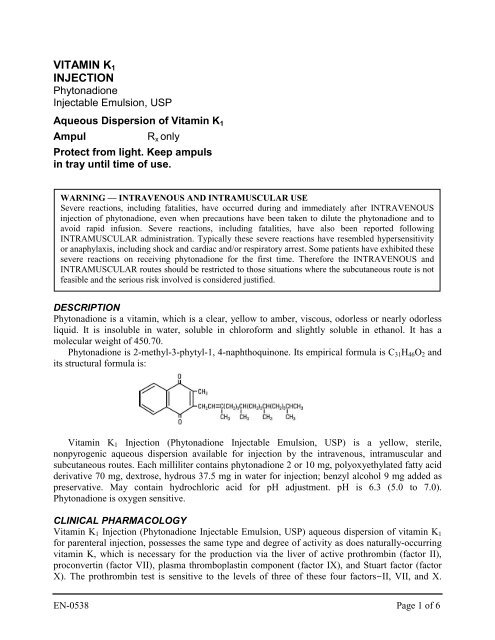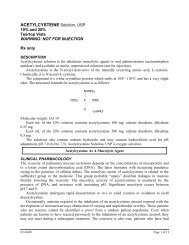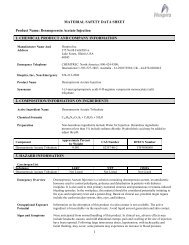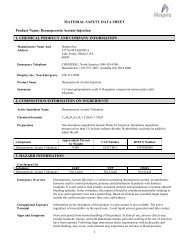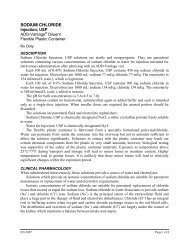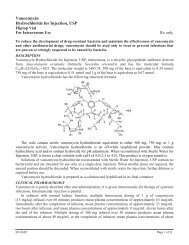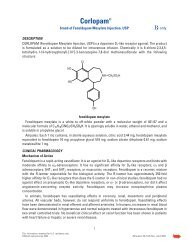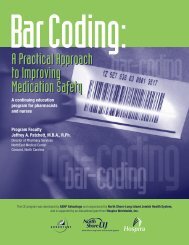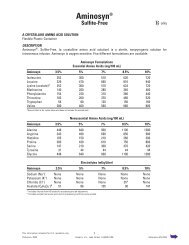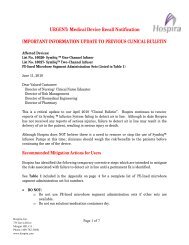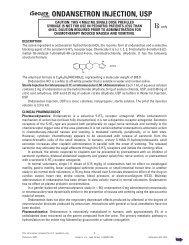Vitamin K1 Injection (Phytonadione Injectable Emulsion ... - Hospira
Vitamin K1 Injection (Phytonadione Injectable Emulsion ... - Hospira
Vitamin K1 Injection (Phytonadione Injectable Emulsion ... - Hospira
You also want an ePaper? Increase the reach of your titles
YUMPU automatically turns print PDFs into web optimized ePapers that Google loves.
VITAMIN <strong>K1</strong><br />
INJECTION<br />
<strong>Phytonadione</strong><br />
<strong>Injectable</strong> <strong>Emulsion</strong>, USP<br />
Aqueous Dispersion of <strong>Vitamin</strong> <strong>K1</strong><br />
Ampul Rx only<br />
Protect from light. Keep ampuls<br />
in tray until time of use.<br />
WARNING — INTRAVENOUS AND INTRAMUSCULAR USE<br />
Severe reactions, including fatalities, have occurred during and immediately after INTRAVENOUS<br />
injection of phytonadione, even when precautions have been taken to dilute the phytonadione and to<br />
avoid rapid infusion. Severe reactions, including fatalities, have also been reported following<br />
INTRAMUSCULAR administration. Typically these severe reactions have resembled hypersensitivity<br />
or anaphylaxis, including shock and cardiac and/or respiratory arrest. Some patients have exhibited these<br />
severe reactions on receiving phytonadione for the first time. Therefore the INTRAVENOUS and<br />
INTRAMUSCULAR routes should be restricted to those situations where the subcutaneous route is not<br />
feasible and the serious risk involved is considered justified.<br />
DESCRIPTION<br />
<strong>Phytonadione</strong> is a vitamin, which is a clear, yellow to amber, viscous, odorless or nearly odorless<br />
liquid. It is insoluble in water, soluble in chloroform and slightly soluble in ethanol. It has a<br />
molecular weight of 450.70.<br />
<strong>Phytonadione</strong> is 2-methyl-3-phytyl-1, 4-naphthoquinone. Its empirical formula is C31H46O2 and<br />
its structural formula is:<br />
<strong>Vitamin</strong> <strong>K1</strong> <strong>Injection</strong> (<strong>Phytonadione</strong> <strong>Injectable</strong> <strong>Emulsion</strong>, USP) is a yellow, sterile,<br />
nonpyrogenic aqueous dispersion available for injection by the intravenous, intramuscular and<br />
subcutaneous routes. Each milliliter contains phytonadione 2 or 10 mg, polyoxyethylated fatty acid<br />
derivative 70 mg, dextrose, hydrous 37.5 mg in water for injection; benzyl alcohol 9 mg added as<br />
preservative. May contain hydrochloric acid for pH adjustment. pH is 6.3 (5.0 to 7.0).<br />
<strong>Phytonadione</strong> is oxygen sensitive.<br />
CLINICAL PHARMACOLOGY<br />
<strong>Vitamin</strong> <strong>K1</strong> <strong>Injection</strong> (<strong>Phytonadione</strong> <strong>Injectable</strong> <strong>Emulsion</strong>, USP) aqueous dispersion of vitamin <strong>K1</strong><br />
for parenteral injection, possesses the same type and degree of activity as does naturally-occurring<br />
vitamin K, which is necessary for the production via the liver of active prothrombin (factor II),<br />
proconvertin (factor VII), plasma thromboplastin component (factor IX), and Stuart factor (factor<br />
X). The prothrombin test is sensitive to the levels of three of these four factors–II, VII, and X.<br />
EN-0538 Page 1 of 6
<strong>Vitamin</strong> K is an essential cofactor for a microsomal enzyme that catalyzes the post-translational<br />
carboxylation of multiple, specific, peptide-bound glutamic acid residues in inactive hepatic<br />
precursors of factors II, VII, IX, and X. The resulting gamma-carboxy-glutamic acid residues<br />
convert the precursors into active coagulation factors that are subsequently secreted by liver cells<br />
into the blood.<br />
<strong>Phytonadione</strong> is readily absorbed following intramuscular administration. After absorption,<br />
phytonadione is initially concentrated in the liver, but the concentration declines rapidly. Very little<br />
vitamin K accumulates in tissues. Little is known about the metabolic fate of vitamin K. Almost no<br />
free unmetabolized vitamin K appears in bile or urine.<br />
In normal animals and humans, phytonadione is virtually devoid of pharmacodynamic activity.<br />
However, in animals and humans deficient in vitamin K, the pharmacological action of vitamin K<br />
is related to its normal physiological function, that is, to promote the hepatic biosynthesis of<br />
vitamin K dependent clotting factors.<br />
The action of the aqueous dispersion, when administered intravenously, is generally detectable<br />
within an hour or two and hemorrhage is usually controlled within 3 to 6 hours. A normal<br />
prothrombin level may often be obtained in 12 to 14 hours.<br />
In the prophylaxis and treatment of hemorrhagic disease of the newborn, phytonadione has<br />
demonstrated a greater margin of safety than that of the water-soluble vitamin K analogues.<br />
INDICATIONS AND USAGE<br />
<strong>Vitamin</strong> <strong>K1</strong> <strong>Injection</strong> (<strong>Phytonadione</strong> <strong>Injectable</strong> <strong>Emulsion</strong>, USP) is indicated in the following<br />
coagulation disorders which are due to faulty formation of factors II, VII, IX and X when caused by<br />
vitamin K deficiency or interference with vitamin K activity.<br />
<strong>Vitamin</strong> <strong>K1</strong> <strong>Injection</strong> is indicated in:<br />
· anticoagulant-induced prothrombin deficiency caused by coumarin or indanedione derivatives;<br />
· prophylaxis and therapy of hemorrhagic disease of the newborn;<br />
· hypoprothrombinemia due to antibacterial therapy;<br />
· hypoprothrombinemia secondary to factors limiting absorption or synthesis of vitamin K, e.g.,<br />
obstructive jaundice, biliary fistula, sprue, ulcerative colitis, celiac disease, intestinal resection,<br />
cystic fibrosis of the pancreas, and regional enteritis;<br />
· other drug-induced hypoprothrombinemia where it is definitely shown that the result is due to<br />
interference with vitamin K metabolism, e.g., salicylates.<br />
CONTRAINDICATION<br />
Hypersensitivity to any component of this medication.<br />
WARNINGS<br />
Benzyl alcohol as a preservative in Bacteriostatic Sodium Chloride <strong>Injection</strong> has been associated<br />
with toxicity in newborns. Data are unavailable on the toxicity of other preservatives in this age<br />
group. There is no evidence to suggest that the small amount of benzyl alcohol contained in<br />
<strong>Vitamin</strong> <strong>K1</strong> <strong>Injection</strong> (<strong>Phytonadione</strong> <strong>Injectable</strong> <strong>Emulsion</strong>, USP), when used as recommended, is<br />
associated with toxicity.<br />
An immediate coagulant effect should not be expected after administration of phytonadione. It<br />
takes a minimum of 1 to 2 hours for measurable improvement in the prothrombin time. Whole<br />
blood or component therapy may also be necessary if bleeding is severe.<br />
<strong>Phytonadione</strong> will not counteract the anticoagulant action of heparin.<br />
EN-0538 Page 2 of 6
When vitamin <strong>K1</strong> is used to correct excessive anticoagulant-induced hypoprothrombinemia,<br />
anticoagulant therapy still being indicated, the patient is again faced with the clotting hazards<br />
existing prior to starting the anticoagulant therapy. <strong>Phytonadione</strong> is not a clotting agent, but<br />
overzealous therapy with vitamin <strong>K1</strong> may restore conditions which originally permitted<br />
thromboembolic phenomena. Dosage should be kept as low as possible, and prothrombin time<br />
should be checked regularly as clinical conditions indicate.<br />
Repeated large doses of vitamin K are not warranted in liver disease if the response to initial<br />
use of the vitamin is unsatisfactory. Failure to respond to vitamin K may indicate that the condition<br />
being treated is inherently unresponsive to vitamin K.<br />
Benzyl alcohol has been reported to be associated with a fatal “Gasping Syndrome” in<br />
premature infants.<br />
WARNING: This product contains aluminum that may be toxic. Aluminum may reach toxic<br />
levels with prolonged parenteral administration if kidney function is impaired. Premature neonates<br />
are particularly at risk because their kidneys are immature, and they required large amounts of<br />
calcium and phosphate solutions, which contain aluminum.<br />
Research indicates that patients with impaired kidney function, including premature neonates,<br />
who receive parenteral levels of aluminum at greater than 4 to 5 mcg/kg/day accumulate aluminum<br />
at levels associated with central nervous system and bone toxicity. Tissue loading may occur at<br />
even lower rates of administration.<br />
PRECAUTIONS<br />
Drug Interactions<br />
Temporary resistance to prothrombin-depressing anticoagulants may result, especially when larger<br />
doses of phytonadione are used. If relatively large doses have been employed, it may be necessary<br />
when reinstituting anticoagulant therapy to use somewhat larger doses of the prothrombin-<br />
depressing anticoagulant, or to use one which acts on a different principle, such as heparin sodium.<br />
Laboratory Tests<br />
Prothrombin time should be checked regularly as clinical conditions indicate.<br />
Carcinogenesis, Mutagenesis, Impairment of Fertility<br />
Studies of carcinogenicity, mutagenesis or impairment of fertility have not been conducted with<br />
<strong>Vitamin</strong> <strong>K1</strong> <strong>Injection</strong> (<strong>Phytonadione</strong> <strong>Injectable</strong> <strong>Emulsion</strong>, USP).<br />
Pregnancy<br />
Pregnancy Category C: Animal reproduction studies have not been conducted with <strong>Vitamin</strong> <strong>K1</strong><br />
<strong>Injection</strong>. It is also not known whether <strong>Vitamin</strong> <strong>K1</strong> <strong>Injection</strong> can cause fetal harm when<br />
administered to a pregnant woman or can affect reproduction capacity. <strong>Vitamin</strong> <strong>K1</strong> <strong>Injection</strong> should<br />
be given to a pregnant woman only if clearly needed.<br />
Nursing Mothers<br />
It is not known whether this drug is excreted in human milk. Because many drugs are excreted in<br />
human milk, caution should be exercised when <strong>Vitamin</strong> <strong>K1</strong> <strong>Injection</strong> is administered to a nursing<br />
woman.<br />
Pediatric Use<br />
Hemolysis, jaundice, and hyperbilirubinemia in neonates, particularly those that are premature,<br />
may be related to the dose of <strong>Vitamin</strong> <strong>K1</strong> <strong>Injection</strong>. Therefore, the recommended dose should not be<br />
exceeded (see ADVERSE REACTIONS and DOSAGE AND ADMINISTRATION).<br />
EN-0538 Page 3 of 6
ADVERSE REACTIONS<br />
Deaths have occurred after intravenous and intramuscular administration. (See Box Warning.)<br />
Transient “flushing sensations” and “peculiar” sensations of taste have been observed, as well<br />
as rare instances of dizziness, rapid and weak pulse, profuse sweating, brief hypotension, dyspnea,<br />
and cyanosis.<br />
Pain, swelling, and tenderness at the injection site may occur.<br />
The possibility of allergic sensitivity including an anaphylactoid reaction, should be kept in<br />
mind.<br />
Infrequently, usually after repeated injection, erythematous, indurated, pruritic plaques have<br />
occurred; rarely, these have progressed to scleroderma-like lesions that have persisted for long<br />
periods. In other cases, these lesions have resembled erythema perstans.<br />
Hyperbilirubinemia has been observed in the newborn following administration of<br />
phytonadione. This has occurred rarely and primarily with doses above those recommended. (See<br />
PRECAUTIONS, Pediatric Use.)<br />
OVERDOSAGE<br />
The intravenous LD50 of <strong>Vitamin</strong> <strong>K1</strong> <strong>Injection</strong> (<strong>Phytonadione</strong> <strong>Injectable</strong> <strong>Emulsion</strong>, USP) in the<br />
mouse is 41.5 and 52 mL/kg for the 0.2% and 1% concentrations, respectively.<br />
DOSAGE AND ADMINISTRATION<br />
Whenever possible, <strong>Vitamin</strong> <strong>K1</strong> <strong>Injection</strong> (<strong>Phytonadione</strong> <strong>Injectable</strong> <strong>Emulsion</strong>, USP) should be<br />
given by the subcutaneous route. (See Box Warning.) When intravenous administration is<br />
considered unavoidable, the drug should be injected very slowly, not exceeding 1 mg per minute.<br />
Protect from light at all times.<br />
Parenteral drug products should be inspected visually for particulate matter and discoloration<br />
prior to administration, whenever solution and container permit.<br />
Directions for Dilution<br />
<strong>Vitamin</strong> <strong>K1</strong> <strong>Injection</strong> may be diluted with 0.9% Sodium Chloride <strong>Injection</strong>, 5% Dextrose <strong>Injection</strong>,<br />
or 5% Dextrose and Sodium Chloride <strong>Injection</strong>. Benzyl alcohol as a preservative has been<br />
associated with toxicity in newborns. Therefore, all of the above diluents should be<br />
preservative-free (see WARNINGS). Other diluents should not be used. When dilutions are<br />
indicated, administration should be started immediately after mixture with the diluent, and unused<br />
portions of the dilution should be discarded, as well as unused contents of the ampul.<br />
Prophylaxis of Hemorrhagic Disease of the Newborn<br />
The American Academy of Pediatrics recommends that vitamin <strong>K1</strong> be given to the newborn. A<br />
single intramuscular dose of <strong>Vitamin</strong> <strong>K1</strong> <strong>Injection</strong> 0.5 to 1 mg within one hour of birth is<br />
recommended.<br />
Treatment of Hemorrhagic Disease of the Newborn<br />
Empiric administration of vitamin <strong>K1</strong> should not replace proper laboratory evaluation of the<br />
coagulation mechanism. A prompt response (shortening of the prothrombin time in 2 to 4 hours)<br />
following administration of vitamin <strong>K1</strong> is usually diagnostic of hemorrhagic disease of the<br />
newborn, and failure to respond indicates another diagnosis or coagulation disorder.<br />
<strong>Vitamin</strong> <strong>K1</strong> <strong>Injection</strong> 1 mg should be given either subcutaneously or intramuscularly. Higher<br />
doses may be necessary if the mother has been receiving oral anticoagulants.<br />
EN-0538 Page 4 of 6
Whole blood or component therapy may be indicated if bleeding is excessive. This therapy,<br />
however, does not correct the underlying disorder and <strong>Vitamin</strong> <strong>K1</strong> <strong>Injection</strong> should be given<br />
concurrently.<br />
Anticoagulant-Induced Prothrombin Deficiency in Adults<br />
To correct excessively prolonged prothrombin time caused by oral anticoagulant therapy—2.5 to<br />
10 mg or up to 25 mg initially is recommended. In rare instances 50 mg may be required.<br />
Frequency and amount of subsequent doses should be determined by prothrombin time response or<br />
clinical condition (see WARNINGS). If in 6 to 8 hours after parenteral administration the<br />
prothrombin time has not been shortened satisfactorily, the dose should be repeated.<br />
<strong>Vitamin</strong> <strong>K1</strong> <strong>Injection</strong> (<strong>Phytonadione</strong> <strong>Injectable</strong> <strong>Emulsion</strong>, USP)<br />
Summary of Dosage Guidelines (See circular text for details)<br />
Newborns Dosage<br />
Hemorrhagic Disease<br />
of the Newborn<br />
Prophylaxis 0.5 to 1 mg IM within 1 hour of birth<br />
Treatment 1 mg SC or IM<br />
(Higher doses may be necessary if the<br />
mother has been receiving oral<br />
anticoagulants)<br />
Adults Initial Dosage<br />
Anticoagulant-Induced 2.5 mg to 10 mg or<br />
Prothrombin Deficiency up to 25 mg<br />
(caused by coumarin or (rarely 50 mg)<br />
indanedione derivatives)<br />
Hypoprothrombinemia 2.5 mg to 25 mg or<br />
Due to other causes more (rarely up to<br />
(Antibiotics; 50 mg)<br />
Salicylates or other drugs;<br />
Factors limiting absorption<br />
or synthesis)<br />
In the event of shock or excessive blood loss, the use of whole blood or component therapy is<br />
indicated.<br />
Hypoprothrombinemia Due to Other Causes in Adults<br />
A dosage of 2.5 to 25 mg or more (rarely up to 50 mg) is recommended, the amount and route of<br />
administration depending upon the severity of the condition and response obtained.<br />
If possible, discontinuation or reduction of the dosage of drugs interfering with coagulation<br />
mechanisms (such as salicylates; antibiotics) is suggested as an alternative to administering<br />
concurrent <strong>Vitamin</strong> <strong>K1</strong> <strong>Injection</strong>. The severity of the coagulation disorder should determine<br />
whether the immediate administration of <strong>Vitamin</strong> <strong>K1</strong> <strong>Injection</strong> is required in addition to<br />
discontinuation or reduction of interfering drugs.<br />
EN-0538 Page 5 of 6
HOW SUPPLIED<br />
<strong>Vitamin</strong> <strong>K1</strong> <strong>Injection</strong> (<strong>Phytonadione</strong> <strong>Injectable</strong> <strong>Emulsion</strong>, USP) is supplied in a package of 25 as<br />
follows:<br />
Amount of<br />
<strong>Vitamin</strong> <strong>K1</strong><br />
List Inj. In<br />
No. Container Container Volume Concentration<br />
9157 1 mL Ampul 1 mg 0.5 mL 2 mg/mL<br />
9158 1 mL Ampul 10 mg 1 mL 10 mg/mL<br />
Store at 20 to 25°C (68 to 77°F). [See USP Controlled Room Temperature.]<br />
Protect from light. Keep ampuls in tray until time of use.<br />
Revised: November, 2004<br />
©<strong>Hospira</strong> 2004 EN-0538 Printed in USA<br />
HOSPIRA, INC., LAKE FOREST, IL 60045 USA<br />
EN-0538 Page 6 of 6


